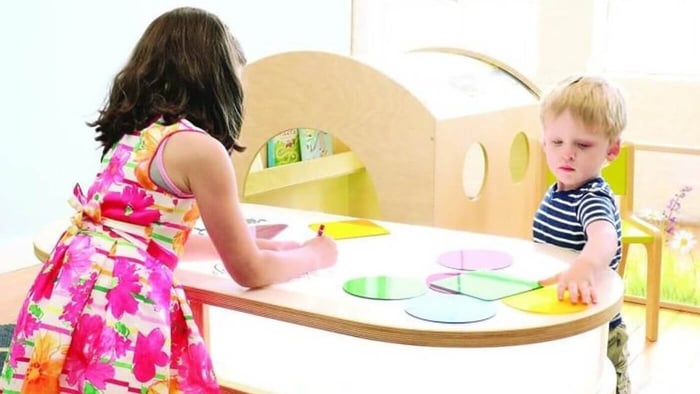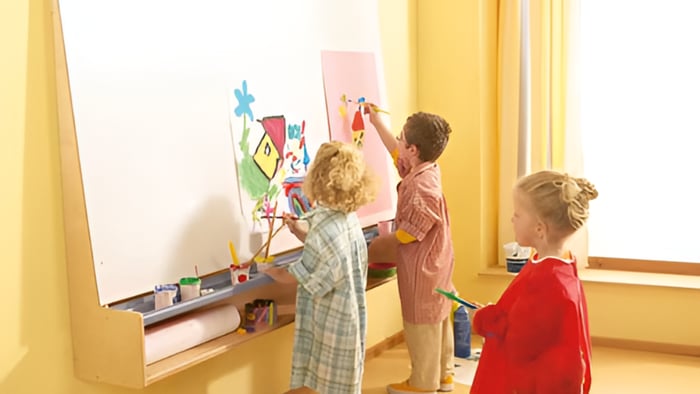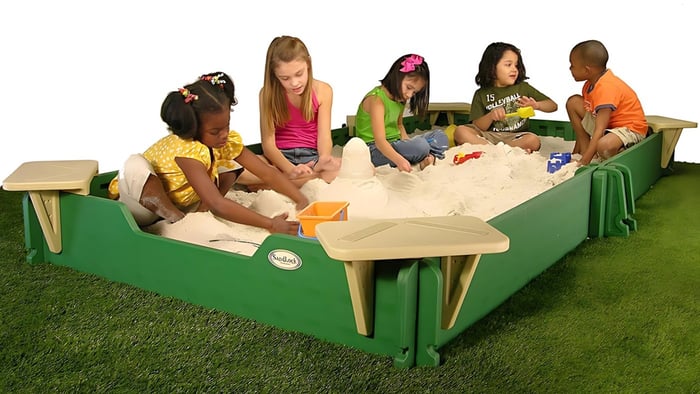
Sensory Table Activities That Build Fine Motor Skills
Table of Contents
- Transform playtime into learning with sensory tables that develop fine motor skills through resistance activities using tongs, tweezers, and various materials. These fun stations strengthen the hand muscles children need for writing while connecting seamlessly to your curriculum goals.
- Key Takeaways:
- The Science Behind Sensory Play and Motor Development
- 10 Best Sensory Materials That Strengthen Little Hands
- 1. Rice and Beans: Perfect for Pouring and Scooping
- 2. Water Beads: Building Grip Strength Through Resistance
- 3. Kinetic Sand: Molding and Shaping for Hand Muscles
- 4. Pom-Poms and Tweezers: Precision Grip Training
- 5. Colored Noodles: Threading and Manipulating
- 6. Chickpeas: Providing Weighted Resistance for Muscles
- 7. Shredded Paper: Tearing and Cutting Practice
- 8. Water Play: Squeezing and Transferring Skills
- 9. Soil with Tools: Digging and Scooping Strength
- 10. Pluffle and Sensory Foam: Texture Discrimination
- Setting Up Effective Sensory Experiences: Tools and Organization
- Curriculum-Connected Sensory Activities That Enhance Fine Motor Skills
- Safety First: Managing Sensory Materials Appropriately
- From Table to Pencil: How Sensory Skills Transfer to Academic Success
- FAQs
Transform playtime into learning with sensory tables that develop fine motor skills through resistance activities using tongs, tweezers, and various materials. These fun stations strengthen the hand muscles children need for writing while connecting seamlessly to your curriculum goals.
Key Takeaways:
- Sensory tables significantly improve fine motor development through activities that strengthen little hands and fingers for future writing skills
- Adding tools like tweezers, tongs, and scoops creates resistance training that builds hand muscles essential for classroom skills
- Little People's Cove sensory tables maximize developmental benefits while keeping classroom mess to a minimum
- Connecting sensory tables to curriculum creates multi-dimensional learning that combines fun with academic goals
- Specific material selection targets different fine motor skills, from pincer grip development to hand-eye coordination
The Science Behind Sensory Play and Motor Development
Sensory tables serve as developmental powerhouses. When children plunge their hands into rice, manipulate water beads, or sift through kinetic sand, they strengthen the same muscles needed for writing, cutting, and other essential classroom skills.
At Little People's Cove, early childhood educators notice that fine motor development happens most effectively through play that engages multiple senses simultaneously. As children scoop, pour, grab, and manipulate materials, they build critical neural pathways between sensory input and motor output.
This motor development occurs in several ways during sensory play:
- Muscle strengthening: Resistance from materials like chickpeas, beans, or sand develops hand strength
- Coordination refinement: Using tools requires precise movements and hand-eye coordination
- Bilateral integration: Many sensory activities require using both hands together in coordinated ways
- Pincer grip development: Small objects and tools promote the finger positioning needed for writing
What makes sensory play particularly effective is that children engage in these motor activities repeatedly without realizing they're "practicing." The enjoyable, open-ended nature of sensory play means kids willingly spend extended periods developing these skills.
Children's Sensory Table w/Shelf

$847.00
The Sensory Table w/Shelf by Jonti-Craft is a versatile and engaging addition to any classroom or daycare setting. This sensory table is specifically designed to...… read more
10 Best Sensory Materials That Strengthen Little Hands
1. Rice and Beans: Perfect for Pouring and Scooping
Rice and beans create an excellent foundation for sensory tables focused on fine motor development. The small grains of rice require precision to handle, while beans offer a satisfying weight that builds muscle strength. Children develop control and coordination when transferring these materials between containers using measuring cups, spoons, or their hands.
Try adding measuring cups of various sizes and small funnels to practice controlled pouring – a skill that requires steady hands and visual tracking. For added challenge, incorporate tweezers for picking up individual beans, which strengthens the pincer grip essential for proper pencil holding. Many teachers find that dyeing rice with food coloring or liquid watercolors creates opportunities for sorting activities that combine fine motor practice with color recognition.
2. Water Beads: Building Grip Strength Through Resistance
Water beads offer a unique sensory experience that specifically targets grip strength. These slippery spheres require children to use precise finger pressure to hold them – too much pressure crushes them, too little and they slip away. This calibration of finger strength is exactly what children need for controlled pencil pressure when writing.
Pair water beads with slotted spoons or sieves to practice transferring them between containers. The resistance of catching the slippery beads builds hand muscles while the delightful sensory experience keeps children engaged. Note that water beads require supervision as they can be a choking hazard for younger children. Store them in sealed containers when not in use to prevent spills and maintain their moisture.
3. Kinetic Sand: Molding and Shaping for Hand Muscles
Kinetic sand provides resistance that naturally strengthens hand muscles as children squeeze, mold, and manipulate it. Unlike regular sand, it holds its shape when pressed, allowing children to practice controlled movements while receiving immediate tactile feedback.
Incorporate small molds, cookie cutters, and plastic knives to encourage cutting, pressing, and shaping – all movements that develop the same muscles used for writing and classroom cutting activities. The sand's unique texture also helps children develop sensory discrimination skills. For curriculum connections, add letter stamps or number molds to practice letter formation and number recognition through a tactile medium.
4. Pom-Poms and Tweezers: Precision Grip Training
Few combinations target fine motor skills as effectively as colorful pom-poms paired with child-safe tweezers. This activity directly develops the tripod grip needed for proper pencil holding as children must carefully position their fingers to operate the tweezers successfully.
Create sorting activities where children must transfer pom-poms by color into different containers using only tweezers. This exercises precision, hand-eye coordination, and visual discrimination simultaneously. The bright colors and soft texture of pom-poms make this activity appealing even to children who might resist traditional fine motor exercises. To maintain organization, store different sizes and colors of pom-poms in separate compartments of a divided container.
5. Colored Noodles: Threading and Manipulating
Dyed pasta noodles with holes (like penne or rigatoni) create opportunities for threading activities that develop bilateral coordination and fine motor precision. Threading pasta onto pipe cleaners or strings requires children to use both hands in coordinated ways – one to hold the string steady and one to manipulate the pasta.
This activity mimics the coordination needed for buttoning, zipping, and other self-help skills while strengthening finger dexterity. The larger size of pasta makes it easier for beginners to handle before progressing to smaller beads. Create a literacy connection by having children thread letters to spell their names or simple sight words.
6. Chickpeas: Providing Weighted Resistance for Muscles
Chickpeas (garbanzo beans) offer significant benefits for hand strengthening due to their substantial weight compared to other sensory materials. When children scoop, pour, or manipulate chickpeas, they're working against resistance that builds strength in the hands and wrists.
These legumes can be easily dyed with food coloring or liquid watercolors to create vibrant sorting activities. Provide small containers, scoops of varying sizes, and tongs to encourage a range of gripping patterns. The weight of chickpeas gives children proprioceptive feedback—sensory information about body position—which helps develop greater body awareness and control needed for classroom tasks.
7. Shredded Paper: Tearing and Cutting Practice
Shredded paper offers unique opportunities for developing the bilateral coordination needed for cutting. Children can further tear the paper into smaller pieces, an activity that requires both hands to work together while building strength in the fingers and hands.
Create a "cutting station" next to your paper sensory bin, where children can practice snipping the paper strips into smaller pieces. This progression from tearing to cutting helps develop the hand strength and coordination needed for more precise cutting tasks in art projects and other classroom activities. Bonus: this material is easy to acquire through office paper recycling!
8. Water Play: Squeezing and Transferring Skills
Water remains one of the most versatile sensory materials for developing fine motor skills. By adding tools like basters, spray bottles, and pipettes, you transform simple water play into targeted finger-strengthening activities.
Spray bottles require children to use their index and middle fingers in isolation—exactly the fingers needed for proper pencil grip. Basters and pipettes develop the squeeze-and-release motion that builds finger strength and control. Add small sponges for squeezing and wringing, which strengthens the whole hand while teaching pressure regulation—a skill directly applicable to writing with appropriate pressure.
9. Soil with Tools: Digging and Scooping Strength
Safe, clean soil or potting mix provides resistance for digging, a whole-hand activity that builds strength in the larger hand muscles. These muscles provide the stability needed for more refined finger movements during writing and cutting.
Include small trowels, scoops, and containers to encourage digging, filling, and dumping. Add plastic plants, seeds, or flower pots to create a gardening center that combines sensory play with scientific learning. This sensory experience connects children to nature while providing excellent heavy work for active children who need to develop hand strength before focusing on more precise fine motor tasks.
10. Pluffle and Sensory Foam: Texture Discrimination
Lighter materials like Pluffle (foam shreds) and foam beads provide opportunities to develop texture discrimination alongside fine motor skills. These materials respond differently to touch than heavier substances, requiring children to adjust their movements accordingly.
The light, airy nature of these materials makes them excellent for practicing gentle movements and precise control. Include tweezers, scoops, and small containers to encourage transfer activities. These materials benefit children who may be sensory-seeking or those who need to develop a lighter touch for classroom activities like turning pages in books or handling classroom materials with care.
See-Thru Wooden Sensory Table
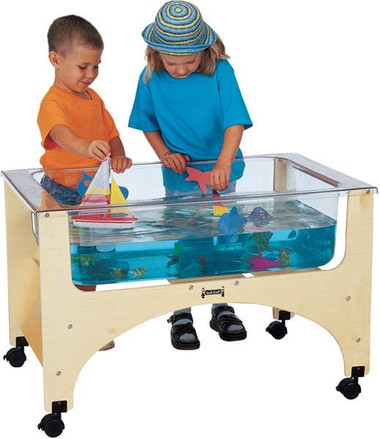
$942.80
SEE-THRU SENSORY TABLE Provides ultimate splash control with clear, tuff, nine-inch deep acrylic tub. Matching see-thru acrylic activity cover included. Locking casters. Ready-to-assemble. 23" wide...… read more
Setting Up Effective Sensory Experiences: Tools and Organization
The right tools transform a simple sensory bin into a fine motor powerhouse. Stock your sensory area with:
- A variety of scoops, spoons, and tongs in different sizes
- Containers of various shapes and sizes for pouring and filling
- Funnels, sieves, and colanders for filtering activities
- Child-safe tweezers and droppers for precision work
- Small brushes for sweeping and cleaning
Organization is key to maintaining an effective sensory area. Use clear containers with lids to store different sensory materials, and label them with both words and pictures. Keep tools in a separate container nearby, or hang them on hooks for easy access. Place a small dustpan and brush near the sensory table to encourage children to clean up spills independently.
A well-designed sensory area includes clear boundaries and expectations. Use a plastic tablecloth or shower curtain under the table to define the space and make cleanup easier. Post simple visual rules showing appropriate use of materials, and consider rotating materials weekly to maintain interest while reinforcing specific fine motor skills.
Curriculum-Connected Sensory Activities That Enhance Fine Motor Skills
Sensory tables become even more powerful when they connect to your classroom curriculum while building motor skills:
- Literacy: Hide magnetic or foam letters in sensory materials for children to find, identify, and sort. Use letter stamps with playdough or kinetic sand to practice letter formation.
- Mathematics: Include measuring cups, scales, and containers of different sizes to study volume, weight, and measurement. Add counting bears or other math manipulatives for sorting and counting activities.
- Science: Create themed sensory tables that correspond with science units—ocean materials during a sea life unit, soil and seeds during a plant unit, or ice and snow during a weather unit.
- Social Studies: Develop culturally-themed sensory experiences that incorporate artifacts, foods, or materials from different cultures being studied.
The key is intentionality—selecting materials and tools that not only build fine motor skills but also reinforce the concepts being taught in other areas of the classroom.
Safety First: Managing Sensory Materials Appropriately
While sensory play offers tremendous benefits, safety must be the priority:
- Always supervise children when using small materials that could pose choking hazards, such as water beads or small beans.
- Be aware of food allergies when using food-based sensory materials like flour, cornmeal, or dried beans.
- Regularly clean and disinfect sensory materials and tools, especially if multiple children use them.
- Choose non-toxic, child-safe materials, particularly for younger children who might still mouth objects.
- Consider keeping separate sensory bins for children who still explore with their mouths, using only taste-safe materials like cooked pasta, oatmeal, or yogurt.
Establish clear rules for sensory play, such as "Materials stay in the table" and "We use gentle hands with friends and materials." Visual reminders near the sensory area can help children remember these expectations.
Youth Double Mite Sand & Water Table
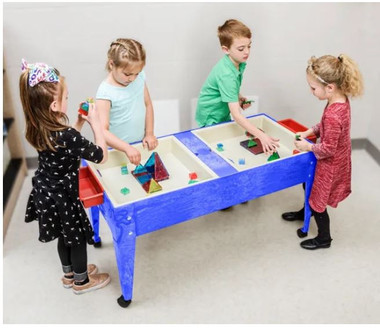
$391.74
The Youth Double Mite Sand & Water Table, manufactured by the renowned brand Childbrite, is a must-have addition to any sensory, sand & water tables...… read more
From Table to Pencil: How Sensory Skills Transfer to Academic Success
The fine motor skills developed at the sensory table transfer directly to academic tasks:
- The pincer grip used with tweezers and small objects is the same grip needed for proper pencil holding.
- The wrist stability developed through scooping heavy materials supports the wrist position needed for writing.
- The bilateral coordination practiced in many sensory activities supports skills like cutting with scissors and holding paper while writing.
- The hand strength built through resistance activities allows children to write for longer periods without fatigue.
- The eye-hand coordination refined through pouring and transferring activities translates to better handwriting and drawing skills.
Research consistently shows that children who have well-developed fine motor skills perform better in reading and mathematics in the early grades. By providing rich sensory experiences that target these skills, you're laying the foundation for academic success.
The sensory table might look like "just play," but it's actually a sophisticated learning center where children develop the physical skills they need for classroom success—all while having fun and engaging their natural curiosity. By thoughtfully selecting materials, tools, and activities, you transform simple sensory play into powerful preparation for academic learning.
For high-quality sensory tables and materials designed specifically to enhance fine motor development in early childhood settings, Little People's Cove offers innovative solutions that support both play and learning.
FAQs
How do sensory tables help develop fine motor skills in kids?
Sensory tables develop fine motor skills by encouraging children to scoop, squeeze, grab, and manipulate objects—motions that strengthen hand muscles and enhance coordination. Using tools like tongs, tweezers, and scoops adds resistance, helping build the hand and finger strength essential for writing, zipping, and other classroom tasks.
What materials at sensory tables are best for fine motor development?
Effective materials include rice, beans, kinetic sand, water beads, or similar small, tactile fillers. Working with these helps children practice precision and control when transferring items between containers or sorting with tools like tweezers and measuring cups. These activities enhance pincer grip, bilateral hand use, and hand-eye coordination.
Are sensory play activities beneficial for overall child development?
Yes—sensory play not only builds fine motor strength but also supports cognitive growth, emotional regulation, and social skills. Children improve memory, language use, and remain calmer through tactile exploration. These benefits extend beyond motor skills, enriching learning and classroom behavior.

